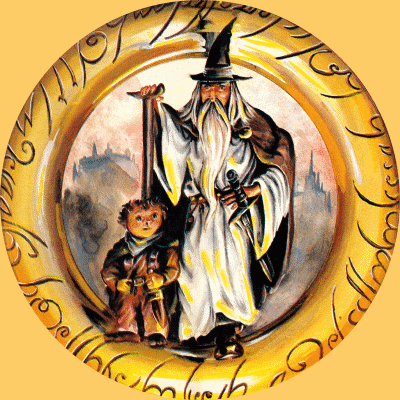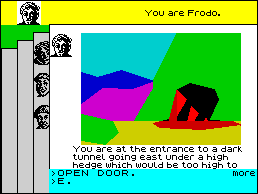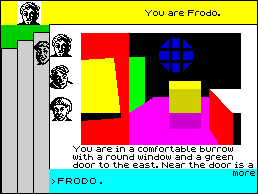| Adventure |
 |

|
I FIRST READ The Lord of the Rings in the strange summer of 1968 - when the conflicts between the forces of oppression and freedom were in sharp focus from the invasion of Czechoslovakia and the seemingly endless inhumanity of the Vietnam war.
The book had been around a while then, but it seemed to reflect same mood of the time and rapidly developed a following. I borrowed three tattered paperback volumes and shut myself in my damp student hovel for four days where as Tolkien himself said, in his writings about fantasy, I went 'out of myself', immersed, convinced and entranced.
The tale of the Ring wars is so involving not just because of its theme, but above all it is the vast scope and coherence of the world of Middle Earth which hooks you into the story.
There are many strange races, each with its varied tongues and cultures, obsessions and preoccupations - the clever, quarrelsome dwarves and their greed for wealth; the powerful elvish lords who dream of the past and the imminent end of their world; the hungry hobbits whose main aim is a well-filled belly, a comfortable chair and a pipe of fine Longbottom or Old Toby. And over all lies the shadow of Sauron, the millennia-old undead sorcerer whose spells and armies threaten to engulf and enslave all the free creatures of Middle Earth.
It is Sauron who dominates the story. Wherever you travel in Middle Earth, his never-closed eye or his servants may see you as they search for the One Great Ring. The magic in this ring is so great that it can, in a sorcerer's hands, be used to conquer the strength of the other rings of power in the world. "One Ring to rule them all ... and in the Darkness bind them, in the Land of Mordor where the Shadows lie."
Sauron's Mordor is the embodiment of hate, evil, unthinking violence and foul sorcery. From this smoking, shattered desolation Sauron sends out his slaves to destroy all nature and all friendship. He will succeed when he recovers his lost Ring ... and once again he becomes aware of its finding when a silly hobbit called Bilbo Baggins steals it from a wet cavern in the Misty Mountains.
If you played The Hobbit and had never read The Lord of the Rings you would never realise the importance of Bilbo's chance find. Nor did Bilbo. Now, after a long wait, Melbourne House have produced the giant sequel to Bilbo's quest. Lord of the Rings - Game One covers the first volume of the trilogy and deals with Frodo Baggins, Bilbo's adopted son, and his journey towards Mordor.
Bilbo is now very old and Gandalf the Wizard arrives at Bag End one day to set Frodo a mission. The mission is to take Bilbo's ring, the One Ring, into Mordor and hurl it into Mount Doom, the volcano where it was forged and the only power which can destroy it forever. If the Ring perished then so does Sauron.
So poor old Frodo not only has to do some extremely unhobbit-like adventuring but has to save the world into the bargain. His servant, Sam, and his relatives Pippin and Merry persuade him to let them come with him ... the game begins.
The Melbourne House programmers in Oz have spent 18 months developing the programs and, after
 the success of The Hobbit, were given a free hand by the publishers and Tolkien's heirs. They have stuck very closely to the story but have added episodes so that you will need more than the books to be able to solve the various parts.
the success of The Hobbit, were given a free hand by the publishers and Tolkien's heirs. They have stuck very closely to the story but have added episodes so that you will need more than the books to be able to solve the various parts.
The package is huge and contains two cassettes, a paperback copy of the first book and a comprehensive instruction booklet. Each cassette holds one part of the game and there are also two beginners' adventures. Those are smaller, less complex versions of the main games, intended as an introduction for those people who aren't too familiar with the story or who want to play an easier scenario.
Generally they have more graphics and less text, objects and locations than the main game and there is no multi-role option. These programs can be played in their own right, without having to carry data over from the first to the second part. However, if you play the second part without loading in your final saved position from the first you will find that you don't have all the friends and objects who will make life a lot easier along the long road.
The first section of Game One takes Frodo and his pals from Bag End out of the Shire to the wild lands beyond Bree, almost to the ford at Rivendell. The second section is the journey from Rivendell, through the mines of Moria and the tree-kingdom of Lothlorien, ending where the company go their separate ways - Sam and Frodo to Mordor and the others off to the war in the south. Melbourne House tells me that it intends to bring out the game of the second book 'hopefully by Christmas '86.'
You play through the eyes of Frodo and his friends and can choose at the beginning whether you want to be Frodo, one of the other three or any combination of the four. That means more than one player can take part and all the characters can have independent lives. If you're on your own any characters you don't have the time or energy to order around will be run by your computer.
When you load in the game you will probably notice that a whole block doesn't load after the initial screen illustration. Don't stop your tape and start cursing Melbourne's copying machines or wailing in frustration - as I did. Let the tape run until the main program loads in - the missing chunk is a restart position which is only needed when you want to start from the beginning again after being cast into oblivion by Sauron. If you are wise enough to be a regular saver you'll probably never need to use this portion. The game format is text adventure with some location graphics for the principal places. The screen shows four overlapping 'pages' - whichever character is currently playing is shown on tap with his portrait. Above that is a strip showing the pictures of the characters you've chosen to use and who you are.
The main text scrolls up the screen and the input buffer is the small area at the bottom. You can type in up to 128 letters at a time and instructions can be separated by punctuation. That lets you do a lot in one go. Melbourne has used Inglish again, as in The Hobbit, and with some limitations you can enter fairly normal sentences - I certainly felt that this works well and seems to be better and more responsive than earlier Melbourne games.
There's a wealth of detail in the descriptions and messages and the screen is often completely filled with words. The response time for the interpreter is not hyper-fast but, given the size of the game and the number of commands you can input in one go, that is not surprising and not a real problem. The only real irritant for me was the way other characters appear one by one - when you're in a large party this process can take a bit of time. Of course, just like The Hobbit, all the creatures live their own lives and you're not likely ever to play the same game twice.
Speaking to the other inhabitants is very important - quite often it will be the only way you have of getting things done. All you have to do is enter 'Say to ...' followed by the command in speech marks. The speech system is more limited than the direct command input and the interpreter will only really understand one or two sets of actions at a time.
Play begins in Frodo's burrow at Bag End. Sam and Pippin are with you and you will need to prepare for the journey by collecting a host of useful objects and stashing them into the backpacks provided. That can be a fairly hilarious business at times as the program will sometimes confuse the packs. You may find Sam putting things into your pack rather than his and I spent some time sorting out this pleasant confusion.
When you're ready and have read Gandalf's note it's time to hit the road and head east to meet
 Merry, who is due to meet you at the Brandywine ford. It's sensible to play Merry as a separate character. I found that if I left his part to the computer he would tend to wander away from the ferry and not be there when we arrived. Going back to look for him is very dangerous - you'll soon realise that the Nazgul, Sauron's terrible Ringwraiths, are already abroad, sniffing you out. Death comes quickly in their presence. These Black Riders will dog your footsteps throughout the game and any unnecessary delays will bring them closer to you.
Merry, who is due to meet you at the Brandywine ford. It's sensible to play Merry as a separate character. I found that if I left his part to the computer he would tend to wander away from the ferry and not be there when we arrived. Going back to look for him is very dangerous - you'll soon realise that the Nazgul, Sauron's terrible Ringwraiths, are already abroad, sniffing you out. Death comes quickly in their presence. These Black Riders will dog your footsteps throughout the game and any unnecessary delays will bring them closer to you.
Before you go east you should explore the Shire a little. Over at Michel Delving there's the Mathom House, a sort of museum. I'm absolutely sure that there are some handy items inside those dusty glass cases but I still haven't been able to get into them.
There's also a book which tells you about the value of elfstones ... could an elfstone be the way to open the cases? The main thing to find here, though, is a light source. Without it you're likely to become trapped in the tunnel leading to the forest and the outside world.
From Michel Delving you can, if you wish, go north. There is a maze of 'winding grassy paths' up there in the Tower Hills and, no doubt, something concealed in it. If you don't become hopelessly lost you'll find your way back to the road. It won't take you long to realise that the river bridge isn't passable and a search through the woods and swamps will bring you to Maggot's Farm. If the dogs bother you just wait a few times for help to arrive.
By the time you reach the tunnel you'll begin to realise that the game is pretty big and not at all simple, especially if the four rather quixotic hobbits are controlled independently. Beware of bringing Merry across the river he isn't meant to be west of it and odd things may happen if you do, like finding that he can be in more than one place at once!
I won't go into detail about the second part of the game but it is worth remembering that if you meet the Elf-Lord Glorfindel in the wild lands you should do what he says and stick to him like glue. Only his power will get you safely into Rivendell and away from sudden death and destruction at the hands of the Ringwraiths.
The game behaves strangely on occasions. Merry's split personality is an example but there are others I typed in "Dig garden" and got the answer "I don't see any dim garden to I am my name is." Of course, this may mean the interpreter has the odd psychotic episode but I'm sure that it is at least attempting to respond. This is better than endless "I can't do that" type messages and is often funny. I once asked Sam to give the food to me - eating is essential for frisky hobbits - and got back "Sam tries to give the food to you but you is too heavy". Don't worry - dieting isn't essential before you begin playing.
Lord of the Rings is essential equipment for any adventurer. The storyline is solidly based on the book and has been faithfully reproduced. Melbourne has added some ingredients but these don't conflict too much with the main tale. There is also a good sized vocabulary to support the interpreter and large numbers of locations to explore, giving a fine feel of space. The graphics are relatively unimportant and, thankfully, the programmers have clearly attempted to cram in as much text detail as possible, rather than too many pretty but useless pictures.
The multi-role/multi-player option is pretty neat. Very few games have used it before but it helps to extend the breadth of an adventure.
Some people will want to play as a group and there is endless scope for argument and debates as well as individual heroics. Oh, and if you get fed up of everyone following you around, just wear the Ring. Invisibility has its uses unless the Nazgul are near. Feel their breath on your neck?
| Richard Price |